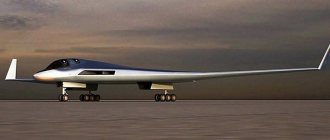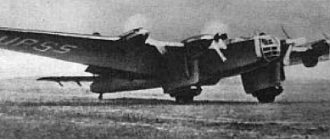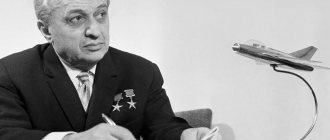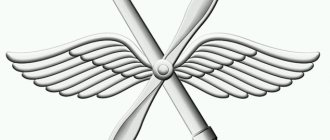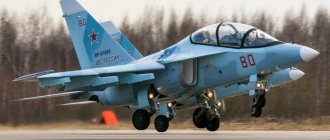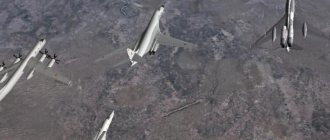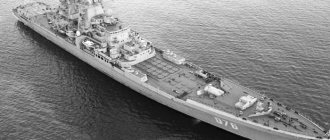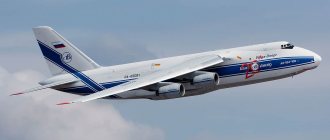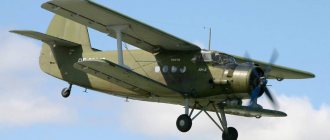The Tu-16 multi-purpose bomber, created on its own initiative, became the first mass-produced Soviet aircraft capable of carrying nuclear weapons over a long distance. The vehicle remained in production for 10 years and remained in service for almost 40 years. Over the years of production, more than fifty modifications of the aircraft were developed and built. The vehicle received the NATO code designation Badger - Badger.
The Tu-16 aircraft was operated not only in the USSR; the aircraft was actively exported to Arab and Asian states. The Chinese copy of the Xian H-6K underwent its last modernization in 2011. The aircraft is equipped with D-30KP-2 turbojet engines.
History of creation
After the Great Patriotic War, the USSR began work on creating its own strategic bomber. Several copies of the American Boeing B-29, which ended up in our country, were used as a sample.
The Soviet version was designated Tu-4 and was successfully operated until the mid-60s. But the Soviet army command understood perfectly well that the era of piston aircraft was ending, so already in 1948, a technical specification for the development of a jet bomber with a long flight range was born.
According to the conditions, the new vehicle had to have a flight range of at least 6,000 km, carry a bomb load of 3,000...7,000 kg and reach a speed of at least 900 km/h.
The vehicle was intended to deliver bombs with conventional and nuclear warheads to the target.
KB A.N. Tupolev began developing a new machine, despite the lack of suitable jet engines. When creating the future Tu-16, the experience of developing the 82 model bomber, which did not go into production, was useful. By the end of the 40s, another prototype aircraft of Project 86 was built.
It was on the basis of this machine that the “88” model was created, which subsequently went into production under the symbol Tu-16. Refining the vehicle and ensuring the crew’s protection from the effects of an atomic explosion took several years. The first production vehicles were ready at the beginning of 1953, and adoption took place in May of the same year.
Design
The Tu-16 bomber is an all-metal monoplane with a swept wing. The wing is installed on the middle part of the fuselage. The tail also has a swept-back shape. The fuselage of the machine has a round cross-section, which is compressed in a number of places.
The power set consists of frames and stringers made by stamping and bending. In places where the power circuit is weakened, additional beams were introduced to strengthen the structure. The outer skin is secured with hidden rivets and works.
Inside, the fuselage is divided into five compartments. During assembly, the compartments were manufactured separately and then assembled into a single structure. The forward part of the fuselage contains two sealed compartments designed to accommodate the crew.
Plexiglas and silicate glass were used to glaze the cabins. Behind the canopy there is a round blister, which was used by the navigator when aiming. Access to the cabins was from below, through a separate hinged hatch.
The next leaking section is equipped with an upper shooting point. Inside are the nose landing gear, two tanks and a rescue boat. The tail section installed further is divided into two sections. The compartment houses the combat load and fuel tank.
An aft sealed cabin equipped with a rifle mount is attached to the rear of the compartment.
The wing of the Tu-16 bomber is assembled from a center section and detachable sections (two on each side). The wing center section is used to install 12 soft fuel tanks. The planes of the flaps and ailerons are located on the rear edge of the wing. Trimmers are mounted on the ailerons. The wing design uses several profiles that vary in span.
The chassis consists of a front steering strut, two main struts and a tail safety support. The control of retracting and releasing the racks, as well as turning, is hydraulic. Double-acting hydraulic shock absorbers are used in the design of the supports.
The nose strut is equipped with a pair of wheels measuring 900*275 mm. The main racks are identical in design, equipped with two paired wheels measuring 1100*330 mm. The racks have a special mechanism that controls the niche doors. When retracted, the racks are secured with locks that prevent accidental release.
The safety support protects the tail of the aircraft during landings with a high angle of attack. The support extends out of the fuselage hydraulically. In the tail of the Tu-16 bomber there is a container designed to store two braking parachutes. The parachute control is electric; after the aircraft stops, the parachute canopies are unfastened by the pilot from the cockpit.
The hydraulics of the Tu-16 bomber consists of the main and brake systems.
The main system is used to control the landing gear and lower the bomb load bay doors. The braking system is used to slow down the landing gear wheels and close the bomb bay doors. The braking system can serve as an emergency braking system and is used to release the landing gear. Pressure sources are pumps located on engine junction boxes.
The Tu-16 bomber was powered by two AM-3 turbojet engines, which were later renamed RD-3. Later aircraft are equipped with uprated RD-3M engines. The engine thrust at takeoff is 8750 and 9500 kg, respectively.
By the end of operation, all Tu-16s had upgraded engines of the RD-3M-500 model. The turbines are located along the fuselage in nacelles. The front part of the nacelle, containing the air intake, is moved beyond the leading edge of the wing. At the rear of the nacelle there is a guide vane that protects the surface of the fuselage from the effects of hot exhaust gases.
The engines have compressors for the pneumatic system. Pneumatics are used to pressurize tanks during an emergency fuel drain, to operate gun reloading systems, maintain pressure in pressurized cabins, and to operate the anti-icing system.
Each engine has two DC generators.
On board the bomber there are two voltage converters that generate alternating current. Rechargeable batteries are used for backup power.
Each engine is equipped with an individual fuel supply system. Systems can be combined into a single whole using a separate backbone. In total, there were 27 soft-type tanks on board the Tu-16, combined into 10 groups.
Accordingly, there were 5 groups for each engine. Each group of tanks is connected to each other by highways and is essentially a separate tank. The volume of fuel depends on the type of kerosene filled - when filling with T-1 fuel, the volume is 41,400 l, TS-1 - 43,750 l.
Some tanks are protected with rubber; consumable groups do not have a protector. The tanks are equipped with an inert gas pressurization system. Tu-16 refueling is carried out on the ground, each group is refueled separately.
A centralized fuel filling system was not used on the bomber.
Later aircraft were equipped with an in-flight fuel receiver located at the end of the left wing. Lines are laid from the receiver to all groups of tanks.
The cannon armament of early series Tu-16 bombers consisted of seven AM-23 cannons of 23 mm caliber. The guns stood in pairs in three remote-controlled installations. Another gun was placed motionless in the forward part of the fuselage. On later versions of the Tu-16K this gun was removed.
The bomb bay allowed the placement of up to 8900 kg of bombs, including the FAB-9000 high-explosive bomb. When installing missile weapons, they were placed under the wings (one KSR-5 under each wing) or in the bomb bay (K-10S missile with partial placement in the flow).
LONG LONG AVIATION OF RUSSIA
The first Soviet mass-produced heavy twin-engine multi-purpose jet - all this is about the legendary Tu-16 long-range aviation aircraft.
Tu-16 (product “N”, according to NATO codification: BADGER - “BADGER”) is a Soviet heavy twin-engine multi-role jet aircraft. It was produced in various modifications, including a missile-carrying version, a tanker aircraft, an electronic warfare aircraft, etc. It was mass-produced from 1953 to 1963 by three aircraft factories.
It was in service with the USSR, Russia and the CIS countries for about 50 years. It was also in service with Egypt, Iraq, Syria and Indonesia, and was produced under the name Xian H-6 in the People's Republic of China. In total, more than one and a half thousand Tu-16 aircraft were produced during production.
Long-range aviation aircraft Tu-16M at the Air Force Museum in Monino.
How it all began
The first Soviet post-war long-range carrier of nuclear weapons was the Tu-4. This piston-powered, four-engine aircraft is essentially a copy of the American B-29 Superfortress. However, already in the second half of the 1940s it became clear that the future of long-range aviation belonged to aircraft with turbojet and turboprop engines. This was confirmed by the results of the Korean War, which showed the difficulty of breaking through powerful air defenses with low-speed B-29s, albeit well-armed ones. In addition, the Soviet navy needed an aircraft to deter the superior surface forces of the Western fleets.
The technical specifications for the creation of an aircraft with an operating range of about 3000 km, transonic cruising speed and a bomb load of 3-7 tons were ready already in 1948. However, its development was hampered by the unavailability of a suitable engine.
Prototypes
At this time, the Tupolev design bureau was developing a number of experimental models that served as prototypes for the Tu-16. Among them, the “82” model should certainly be mentioned. It was the first front-line bomber with a swept wing and two jet engines. The “82” aircraft did not go into production due to the fact that the Il-28 of the competing design bureau Ilyushin was adopted. However, his developments were used in the design of the Tu-22 front-line bomber. The immediate predecessor of the Tu-16 was Project 86, the development of which began at the end of 1948 and was completed by the summer of 1949. The project, for example, assumed a flight range of up to 4000 km with 2 tons of bombs, a maximum speed at an altitude of 6000 m - 980 km/h, and a service ceiling of 13400 m.
On August 29, 1949, the USSR tested the RDS-1 nuclear bomb and began preparations for mass production of the RDS-3 bomb. New long-range bombers were supposed to deliver this product, whose weight exceeded 5 tons, to the target. The nuclear weapon required not only a thermostated bomb bay, but also measures to protect against the effects of damaging factors of nuclear weapons on the crew and the aircraft. What was needed was a bomber that could deliver a nuclear bomb at a range accessible to the Tu-4, but could fly twice as fast as it. Research by the Tupolev design bureau on the “86” project showed that a high-speed long-range jet carrier for nuclear weapons can only be achieved by increasing mass and size, with an increase in engine thrust by 1.5 - 2 times.
Thus began the “88” project with the placement of more powerful engines in the wing root, and not under it, which was developed proactively for some time. Some of the decisions of the “86” project, namely, the composition and location of the crew, defensive weapons, were transferred to the “88” project. The Tu-16 long-range aviation aircraft subsequently appeared from the “88” project. The preliminary design of the aircraft was approved on July 5, 1951.
The design of the Tu-16 included a number of features that were unique to it, giving the aircraft a very characteristic appearance. These include engine nacelles “recessed” into the fuselage, a large sweep of the tail, as well as a rigid structure of a high aspect ratio wing.
First jet strategist
The main purpose of the Tu-16, of course, is to solve various strategic problems. Engineers from the Tupolev design bureau began working on the creation of the aircraft in 1950. And already on April 27, 1952, the first prototype took to the skies. At the end of the year, this aircraft was put into mass production. Tu-16 aircraft first joined the strategic aviation ranks in 1954. The design of this aircraft was distinguished by the presence of a swept mid-wing and empennage of the same shape. The fuselage of the aircraft consisted of five compartments and had a circular cross-section. The bomber's cabin is highly airtight. It was divided into two compartments and reinforced with armored glass and protective plates. The plane's crew consisted of six pilots. The main engines of the vehicle were two turbojet units of various modifications. The bomber could carry up to 9 tons of bombs, which were placed in one compartment. The Tu-16 could be armed not only with bombs, but also with guided cruise missiles KS-1, KSR-5 and K-10S.
|
|
Performance characteristics of the Tu-16
Tu-16K-10-26 of the Northern Fleet Air Force with a full missile suspension - two KSR-5 and K-10S.
| Modification | Tu-16K-10 |
| Wingspan, m | 32,99 |
| Length, m | 34,8 |
| Height, m | 10,36 |
| Wing area, m2 | 164,65 |
| Empty aircraft weight, kg | 37730 |
| Normal take-off, kg | 72000 |
| Maximum take-off, kg | 79000 |
| Fuel, kg | 36000 |
| engine's type | 2 × RD-3M or RD-3M-500 turbojet engines |
| Thrust, kgf | 2 x 9500 |
| Maximum speed, km/h | 992 |
| Cruising speed, km/h | 842 |
| Ferry range, km | 7200 |
| Flight range, km | 4800 |
| Combat radius, km | 3050 |
| Practical ceiling, m | 15000 |
| Crew | 6-7 people, depending on modification:
|
| Cannon weapons | 6 AM-23 guns (three twin turrets with remote control). |
| Bomb load | 8900 kg in the weapons compartment (the ability to carry FAB-9000 or a nuclear bomb). |
| Missile weapons | In the naval version, the Tu-16K-10-26 missile carrier carried out flights with two KSR-5 missiles (one under the wings) and one K-10S missile under the fuselage (half-recessed in the bomb bay). The resulting combat load was 12,410 kg. |
Tu-16 modifications
The model turned out to be so successful that many different modifications were released based on it. In addition, Russia’s first strategic jet aircraft, the Tu-16, is undoubtedly and rightfully considered a long-liver in aviation. It was only withdrawn from service in 1994.
It should be noted that combat aircraft were converted into various variants several times during operation. An accurate count of all modifications is most likely no longer possible. There were many aircraft of the same modification, but with different equipment. For example, in a jammer squadron it was possible not to find two identical aircraft. Some of the aircraft were redesigned for specific missions and could only be in service with one specific regiment.
“88” is a prototype; at the beginning of 1952, 2 aircraft were manufactured.
Tu-16 (product N, Badger A) - medium bomber, long-range aviation aircraft, the first production modification, produced since 1953.
Tu-16 "Cyclone-N" - was intended for active influence on clouds, as well as for studying the thermodynamic parameters of the atmosphere. Two missile carriers from the Navy were converted to the Pushkin ARP in 1977. The set of special equipment consisted of KDS-155 cassette holders for shooting PV-50 weather squibs with silver iodide, and a container for bulk substances (mainly “600” grade cement). It was planned to hang K-76(l) type containers with reagent or KMG-U type containers on the external pylons. Both aircraft were based at the Chkalovsky airfield. They were used during the Olympics-80, during the liquidation of the accident at the Chernobyl nuclear power plant and to “disperse clouds” in central Russia.
Tu-16A (product NA) is a strategic bomber that carries nuclear weapons. It featured a bomb bay with thermal insulation. Produced since 1954. The most widespread modification - 453 vehicles were built. From one of them, on October 27, 1967, the first Chinese thermonuclear bomb was dropped.
Tu-16AFS is an aircraft for special aerial photography. AFA-42/20 were installed in the cargo compartment. One aircraft was converted and used for photographing the Baikal-Amur Mainline.
Tu-16B is a medium bomber, an experimental modification with M-16-15 (RD16-15) engines. Manufactured in 1957.
Kuzka's mother
Tu-16V is a strategic bomber, built in triplicate, carrying a hydrogen bomb similar to the super-powerful device exploded on October 30, 1961 on Novaya Zemlya (“Tsar Bomba”, “Kuzkina Mother”).
Tu-16G - the only aircraft with the number USSR-L5411 was converted into a training aircraft for training civil aviation crews on the Tu-104, and was listed according to the documentation as the Tu-104G.
Tu-16E "Azalea" (Badger K) is an electronic reconnaissance and electronic warfare aircraft. It was equipped with an active jamming station “Azalea”.
The Tu-16E-XP was an aircraft for photographic, radio engineering, radiation and chemical reconnaissance and was close in equipment to the Tu-16RR; containers for taking air samples were installed under the planes. The crew is seven people.
Tu-16Z (Tu-16Yu, Tu-163[20], product NZ) - tanker. Equipped with a wing-based refueling system. Developed in 1955. More than 100 Tu-16A aircraft have been converted.
Tu-16ZA is a bomber with an in-flight refueling system. It was distinguished by the presence of a fuel receiver on the left wing (later on both).
Tu-16ZShch - tanker. Unlike the Tu-16Z, it had a refueling system used for refueling through a “cone”. Used for refueling Tu-22.
TO
Tu-16K - three experienced missile carriers (for K-10S missiles) with RD16-15 engines with an increased flight range. The tests were carried out successfully, but the aircraft did not go into production.
Tu-16K-10 (Badger C) is a long-range bomber-missile carrier of the K-10S guided missile. It was distinguished by an elongated nose radio-transparent fairing for the parabolic antenna of the "EN" radar. Serially produced since 1959. Adopted only by the Navy aviation in 1961. 216 vehicles were built or converted.
Tu-16K-10(ZA) is a missile carrier with an in-flight refueling system. It was distinguished by the presence of a fuel receiver on the left wing.
Tu-16K-10-26 (Badger C (mod)) is a long-range missile-carrying bomber. Carrier for K-10S, KSR-2 and KSR-5 missile launchers.
Tu-16K-10-26B is a modified version of the Tu-16K-10-26. In addition to missiles, it could carry bombs of 100-1500 kg caliber on 12 holders under the wing and fuselage.
Tu-16K-11-16 (Badger G) is a long-range bomber-missile carrier of K-16 (KSR-2) and K-11 (KSR-11) guided missiles. Developed in 1963. It was distinguished by the presence of a radio intelligence station "Ritsa" and the absence of a bow cannon. The Tu-16, Tu-16A, Tu-16Z, Tu-16KS aircraft were converted to the Tu-16K-11-16 standard.
Tu-16K-16 (Tu-16KSR, Tu-16KSR-2, product NK-3) - carrier of the K-16 missile launcher (KSR-2). Developed in 1956-1958. Entered service in January 1962. Tu-16KS aircraft were converted into Tu-16K-16.
Tu-16K-16-26 (Tu-16KSR-2-5) - carrier of the K-26 missile launcher (KSR-5). This designation was given to the Tu-16K-11-16 aircraft after conversion to the Tu-16K-26 type.
Tu-16K-22 is the carrier of the Kh-22 missile. These aircraft were armed with the only regiment in the USSR, stationed in the Primorsky Territory.
Tu-16K-26 (Badger-G(mod)) is a long-range missile-carrying bomber. Carrier missile launcher K-26 (KSR-5). Entered service on December 4, 1969.
Tu-16K-26P (product NK-26P) - carrier of KSR-5P missiles. Developed in the early 70s.
TO*
Tu-16KRM is a carrier of target missiles. Could carry targets KRM-1, KRM-2, KSR-5NM, KSR-5NV. Several aircraft were re-equipped by order of the Air Defense Forces.
Tu-16KRME is a variant of the MV-1 (KRM-2) target carrier, converted from the Tu-16E jammer. The plane had SPS-1 and SPS-2 stations. "Lilac" and ASO-16 assault rifle. When launching targets, the Tu-16KRME could further complicate the operation of the air defense system by setting up active and passive jamming. The crew, as on the Tu-16E, consisted of seven people.
Tu-16KS (Badger-B) is a long-range bomber-missile carrier of KS-1 "Comet" anti-ship missiles. A Kobalt-M guidance radar is installed in the bomb bay. It was not accepted for service, although it was used in naval aviation and was exported (about 40 aircraft of this variant were delivered to Indonesia and Egypt).
Tu-16KSR (KSR-2) (product NKSR-2, Badger-G) is a long-range missile-carrying bomber for KSR and KSR-2 missiles.
Tu-16KSR-2-11 is a missile carrier aircraft that could carry KSR-2 and KSR-11 missiles in any combination, as well as free-falling bombs. 156 Tu-16A and Tu-16A(ZA) bombers were converted to this version, and Tu-16KSR-2A missile carriers were also modified. In some cases, the Tu-16KSR-2-11 was designated as the NK-11-16 product or the NK-2 product.
Tu-16LL - flying laboratories for testing various engines. A unit with a hydraulic drive was mounted in the cargo compartment, which released the engine downwards. For emergencies there was a reset mechanism. A total of 9 aircraft were converted for engine testing. The aircraft were in operation for 30 years, and almost all Soviet turbojet engines of the 2nd and 3rd generations were tested on them. There were also several Tu-16s with other experimental devices, all of which were passed as "flying laboratories". On February 1, 1971, twice Hero of the Soviet Union Amet-Khan Sultan died on one of these planes.
M
Tu-16M is a radio-controlled target, converted from an exhausted Tu-16. The name Tu-16M was given to aircraft converted only at the Kazan Aviation Plant. Khabarovsk ARZ No. 12 also dealt with target aircraft. At the same time, jamming stations were left on the aircraft and, depending on the configuration, they were called M-16-1, M-16-2, M-16-3. The target was designed for five flights, four with a crew. After starting the engines and taxiing to the start, the crew left the car, then the final flight of the target took place according to radio commands from the ground. In case the anti-aircraft gunners missed or suffered non-fatal damage when a missile hit (this also happened), self-destructors began to be installed on the targets.
Tu-16N (product NN) - tanker for Tu-22 aircraft. Equipped with a “hose-cone” filling system. To make it easier to maintain formation when refueling, a red stripe was applied along the bottom of the fuselage on the Tu-16N. Beginning in 1963, at the Kazan plant, some bombers were converted into Tu-16N tankers.
Tu-16NM is a carrier of targets of the D-5NM and D-5MV types.
Tu-16NKRM is a variant of the target carrier, created in 1964. Under each of its wing consoles, one high-altitude high-speed target (target simulator) ITs-59 “Deer” weighing 540 kg, equipped with a liquid-propellant rocket engine, was suspended. In 1980, improved targets ITs-59V “Magnit” weighing 1052 kg entered service.
Tu-16P “Bouquet” (Badger J) is an electronic warfare (group defense) aircraft. It was equipped with a “Bouquet” active jamming station. In the early 70s they converted to this modification
Tu-16P "Yolka" (ed. "NE", "Badger H") - an electronic warfare aircraft - a passive jammer; containers with half-wave dipoles ASO-16 and ASO-2B were installed in the cargo compartment. Could be used as a bomber after dismantling the ASO-16. Since 1960, all Tu-16SPS have been re-equipped.
Tu-16PL (PLO) - anti-submarine. One squadron each was experimentally converted to the Northern Fleet and Pacific Fleet. It could carry jettisonable sonar buoys and anti-submarine weapons, and had Baku equipment on board. The experiment was considered unsuccessful.
R
Tu-16R (“product 92”) - long-range reconnaissance aircraft. It featured 7 cameras, an active jamming station, and SRS-3 electronic reconnaissance equipment in hanging containers under the wing. Developed in 1955.
Tu-16RM is a reconnaissance and target designation aircraft. Aerial cameras AFA-41/20, AFA-42/20, AFA-42/75, AFA-42/100, NAFA-MK-75, an SRS-4 electronic intelligence station and a Rubin-1 K radar were installed. Several Tu-16K-10s have been converted.
Tu-16RM-1 (RM-2) is a maritime electronic reconnaissance and electronic warfare aircraft. The "EN-R" radar, SRS-1 and SRS-4 stations, AFA-33/20M and AFA-42/75 cameras were installed. Some cars had jamming stations. Converted from Tu-16K-10 were called Tu-16RM-1, and from Tu-16K-10D - Tu-16RM-2. A total of 23 aircraft were operated.
Tu-16RR is a radiation reconnaissance aircraft. It was distinguished by hanging containers with equipment for taking air samples. Developed in 1970. 7 Tu-16Rs were converted.
Tu-16RT is an aircraft measuring point for testing the Burya cruise missile. In 1956, 6 Tu-16R aircraft were converted.
Tu-16RTs is a flying laboratory for testing the P-6 missile guidance system. Manufactured in 1964.
WITH
Tu-16S - maritime search and rescue. Equipped with the Frigate drop boat. At the end of the 60s, several Tu-16Ts were converted. It was in service until the mid-80s.
Tu-16SP is an anti-submarine aircraft.
Tu-16SPS is an electronic warfare aircraft (jammer). SPS-1 and SPS-2 stations were installed on board, and an additional special operator’s cabin was installed in the cargo compartment. Crew - 7 people, produced since 1955, later converted to the "Bouquet" variant.
Tu-16T (product NT) - torpedo bomber. Produced since 1957 by the Voronezh plant. 76 vehicles were built or converted. The aircraft could carry two RAT-52 jet torpedoes, six 45-54VT high-altitude torpedoes (or low-altitude 45-56NT), two VB-2F depth charges, 12 AMD-4-500 aircraft bottom mines or four AMD-4-1000 mines. And also, reactive pop-up mines RM-1 and RM-2, universal bottom mines UDM, bottom mines MDM-3, MDM-4, MDM-5, “Serpey”, anchor mines “Lira”, mines of the AMD- type could be suspended. 2M, IGD-M, “Desna”, training mines-bombs UPAMB-100/80, torpedoes 45-36MAV. The total weight of the weapons reached 8.7 tons. In addition, the Tu-16T could take the full set of weapons of a conventional bomber - up to 9 tons. Despite the emergence of much more effective missile carriers, it was in service until 1972.
Tu-16TRZhK is an aircraft for transporting liquid oxygen.
Tu-104 is a passenger aircraft. It was distinguished by a fuselage of increased diameter. First flight June 17, 1955. In 1956-1960, 201 aircraft were manufactured.
Tu-107 is a military transport aircraft based on the Tu-104. It featured a larger diameter fuselage. Made in one copy.
The Xian H-6 is a variant of the Tu-16 medium-range bomber produced in China under license. At least 200 aircraft were manufactured.
- Xian H-6A - Chinese strategic bomber - carrier of nuclear weapons
- Xian H-6-IV - Chinese naval bomber - missile carrier for Shangyu-type anti-ship missiles (export index - C-601, NATO designation - Silkworm).
“97” is a project for modifying the Tu-16 for two VD-5 engines and increased wing sweep to 45 degrees.
“103” is a project for modifying the Tu-16 for four VD-7 or AM-13 engines. It was planned to create a supersonic bomber.
Combat use
The first vehicles began to enter service at the end of the winter of 1954. Since its introduction, the Tu-16 bomber has become the main vehicle in the strategic deterrence forces. The aircraft was used to test new types of weapons. Tu-16A vehicles were used to deliver nuclear warheads to release points at the Semipalatinsk test site.
The USSR used Tu-16 aircraft during the fighting in Afghanistan.
Bombs of the FAB-500 type were used for bombing, as well as heavy aerial bombs weighing up to 9000 kg. The largest FAB-9000s were actively used in the final stage of the war. By this time, the Tu-16 long-range bomber remained the only vehicle capable of delivering such weapons to the target.
Bombs were used to destroy roads, caves and create rubble. Tu-16 bombers of the Egyptian Air Force took part in the Arab-Israeli wars of the 60s and 70s. During the Six-Day War, one of the Egyptian planes made a fiery ramming attack on an Israeli military base.
The Tu-16s delivered to Iraq were actively used during the Iran-Iraq War to attack tankers exporting oil products from Iran. By 1991, Tu-16 bombers departing for service were stationed at airfields. Some of them were destroyed by allied air attacks, some were later dismantled for metal.
Armament and equipment
The aircraft's cannon armament consisted of seven twenty-three-millimeter AM-23 cannons. They were located in three remote tower installations and one bow. KOU could take control of everyone. The engineering features of the design left the military greater freedom in the practical use of free-falling bombs. The ammunition compartment is designed for 3000 kg, but if you need to create a planned overload, then the Tu-16 is able to lift 9000 kg in the compartment and also carry trailed bombs on the wings. This meant that the aircraft could drop the FAB-9000M-54 anti-ship high-explosive bomb, which was capable of seriously damaging and even sinking an enemy aircraft carrier.
Tu-16, preparation
Various modifications of the bomber made it possible to use literally all types of aviation ammunition of that time. These are bombs, torpedoes, mines and cruise missiles. In the missile carrier version, the Tu-16 carried three cruise missiles with a total weight of more than 12 tons. Bombs could also be hung on it.
The Tu-16 was equipped with advanced instruments and electronic systems for those times. There was the possibility of combat use of the vehicle at any time of the day, in any weather conditions and hitting visible and invisible targets.
Tu-16, monument in Ryazan
Modifications
Based on the Tu-16, several dozen modifications of vehicles were created, which were used as bombers, reconnaissance aircraft or training aircraft.
Some of the most popular versions of the aircraft:
- Tu-16, first production version;
- Tu-16A, a variant with a thermally insulated bomb bay designed to accommodate nuclear weapons;
- Tu-16V, carrier of the super-powerful atomic “Tsar Bomb”;
- Tu-16Yu or Tu-163, is a modification of the tanker;
- Tu-16K-10, designed to deliver K-10S guided missiles to the launch site;
- Tu-16K-22, armed with Kh-22 missiles.
In addition, there were a lot of aircraft produced in small batches or in single copies. On the basis of the bomber, the first Soviet jet airliner Tu-104 was created, which was actively used until the early 70s.
Performance characteristics
In the 50s of the last century, a number of bombers appeared with a concept similar to the Tu-16. Therefore, it makes sense to compare the technical and flight characteristics of the machines.
| Parameter | Tu-16 | B-47A | Vickers Valient |
| A country | USSR | USA | Great Britain |
| Engine thrust at takeoff, kg | 21300 | 19596 | 18160 |
| Take-off weight, kg | 79000 | 104326 | 79380 |
| Maximum flight speed, km/h | 1050 | 978 | 910 |
| Flight range, km | 5925 | 3797 | 7240 |
| Ceiling, m | 12800 | 12344 | 16460 |
The fundamental difference between the Tu-16 and American or British vehicles is its cannon armament, which provides reliable protection against attacks from the tail. The B-47A used a single installation located in the tail section. The British bombers did not carry small arms.
Incidents
Of the 1,511 Tu-16 jet bombers built, 145 aircraft were lost in accidents, i.e. almost 10%. As a result of the disasters, 709 people died. The bulk of the disasters occurred in the 50s, when the development of the machine and new flight methods was underway.
The last accident involving a Tu-16 dates back to the fall of 1990. When transporting the vehicle for disposal, the aileron drives were destroyed, which led to the plane crashing on takeoff. The crew members located in the bow cabin were killed, while those in the rear remained alive.
In 1958, one Tu-16 landed on drifting ice floes.
The airfield was used to supply the Arctic station, so it had an Il-14 passenger plane. When attempting to take off, the vehicles collided and were damaged, which was impossible to repair on the spot.
The damaged Tu-16 drifted along the ice for almost a year before it was discovered by a Canadian Air Force reconnaissance aircraft. After this, the car was dismantled and burned.
Technical features of the Tu-16
In the final basic version, the aircraft was a monoplane with a mid-sweep wing of 35º along the quarter chord line. The wing is a two-spar, coffered design, reinforced at the engine locations. Until 1958, it was powered by Mikulin AM-3 turbojet engines with a thrust of 8750 kg. After 1958, RD-3M-500 with a thrust of 9520 kg were installed. The number “500” means the number of hours that the engine can be operated without major repairs. A few years later this parameter was increased to 2000.
The fuselage is cigar-shaped with a characteristic narrowing towards the tail. Inside it is divided into six compartments. In the front zone, immediately behind the canopy, there is the main pressurized cabin for the crew, and in the rear part there is a pressurized cabin for the gunner-radio operator and the commander of the firing installations. The placement of a classic six-person crew is described.
In the center of the fuselage is the internal weapons compartment, and behind it are the fuel tanks.
Tu-16
The very first seat in the bow is designed to accommodate the navigator-bombardier. He also serves as a radar operator. Behind him are the seats of the commander, co-pilot and navigator-operator. The observation hatch of the astrodome is located above the latter's head.
The fuel system was divided into 10 sections, which combined 27 tanks in the wings and rear fuselage. In total, they held 43,800 liters of TC or T-1 fuel.
The control system is classic, with mechanical wiring. Roll, pitch and heading control were carried out by ailerons and rudders, which could be successfully used in piston aircraft.
Tu-16 diagram
Traces in history and surviving copies
To date, at least 19 vehicles based on the Tu-16 have been preserved, which are located in various museums in Russia, Ukraine and Belarus.
The Tu-16 bomber remained in service until the second half of the 80s, while its British and American competitors were quickly written off. Moreover, as of 2012, the Chinese Air Force had at least 160 copies of a licensed copy under the designation N-6.
The creation of the Tu-16 bomber accelerated the development of Soviet military and civil aviation. The machine tested new casting and stamping technologies, and also tested high-strength structural materials.
The swept wing concept was further developed in the developments of the Tupolev Design Bureau, created in the 50s and 60s.
Tu-16 aircraft have become a training ground for testing in-flight refueling systems, without which modern military aviation is unthinkable.
A large number of Tu-16s of various modifications can be seen in the film “Case in Square 36-80”, filmed in 1982. Tu-16 bombers are occasionally shown in the film “Peculiarities of the National Hunt,” filmed in 1995. Episodes of the film were filmed at the Veretye army airfield (district of the city of Ostrov), which was used as a storage base for decommissioned vehicles.
Video: Bomber TU-16.
https://youtu.be/44xd6lbuYSU
In the USSR, the aircraft was put into service in 1954 and removed from it in 1993, already by order of the Ministry of Defense of the Russian Federation. Production ceased in 1963. In our country, 1507 serial and 2 prototypes were produced. However, the Tu-16 was supplied and then produced under license in China. It is still in service in China to this day. There is information that its use has not been completely abandoned in Egypt. The problem of obtaining spare parts for the Air Force of this country is being solved with the help of China. The Chinese licensed version is called Xian H-6 .
This development also has its own peaceful history, which is connected with civil aviation. The Tu-16 became the basis for the development of the first Soviet jet passenger aircraft, the Tu-104 . From the military, the passenger airliner “got” a wing, which was transferred to the lower part of the fuselage, tail unit, engine nacelles and landing gear.
